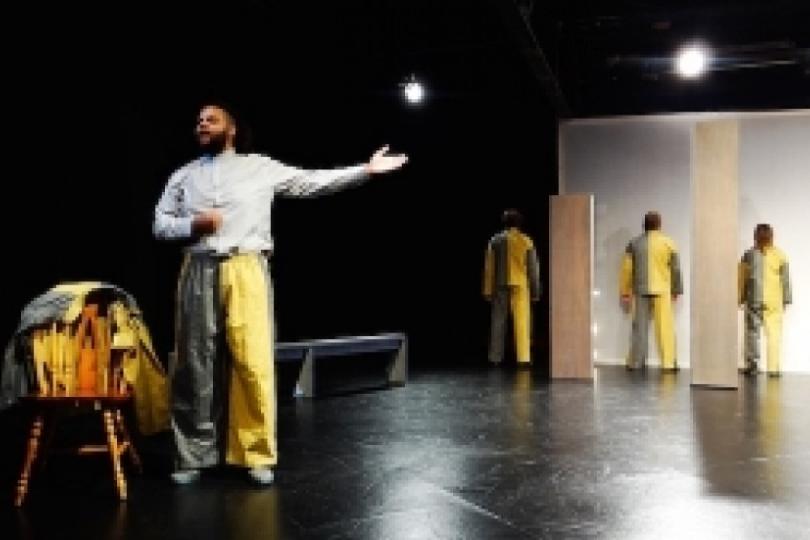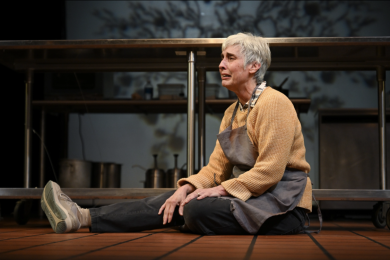REVIEW: The crimes are greater than you think
Review

I hesitate to use the word epic, not because Sandbox Theatre’s Killer Inside isn’t an ambitious, sprawling show filled with poetry, but because we live in an era where “epic” is more often used to describe things made with bacon.
Still, Killer Inside is Epic in the way that The Poetic Edda is epic, all recursive and symbolic and based on a people’s oral traditions. It is not epic in the way a bro would describe a slice of pizza.
But Killer Inside is not an epic about heroes exactly. The oral tradition Sandbox Theatre has drawn from is the murder ballad, a creepy little subgenre of folk music. This is about men and women who committed a wide variety of murders, from infanticide to serial, from heat-of-the-moment to for-hire, and who are now paying the price and doing the time at Pittsville Penitentiary. Each is introduced and each has an original song. The music’s range matches the range of the crimes: some songs are barely controlled eruptions, others are gracefully somber. Occasionally they’re punctuated with things like tap dancing.
A musical, Killer Inside was developed by its ensemble (under Heather Stone’s direction), something the artistic harmony of the songs doesn’t betray. That is, the songs, though written by a whole bunch of folks, are wide-ranging but not undisciplined. There is a sense of clarity that is normally the product of a single hand (or maybe two) instead of nine. Parts of the score are simply beautiful, so obviously Sandbox’s approach is working out for them really, really well.
Personally, I’ve never been involved in a collaborative effort like this, so I’m predisposed to look at Sandbox’s methodology with a sort of skeptical admiration. I’m just enough of a control-freak introvert to view the collaborative process that produced Killer Inside as a living hell. So super kudos, Sandbox, and you keep doing you.
Is it the system or is it us?
Killer Inside frames its discussion of criminality in universal, elemental terms. This is a necessary condition of all non-bacon epics. Here, as it often is, the vocabulary is good versus evil, The Light versus The Dark. Without such stakes, The Odyssey, for example, would have been little more than the ancient world’s Lonely Planet: Mediterranean Sea. But I am not entirely sure Killer Inside required such metaphysics. Or, rather, I think that Killer Inside could have set aside the demon wrestling and talked about good and evil as they manifest themselves within American law. Our criminal justice system has enough contradictions, inconsistencies, ambiguity and sadism to fill a thousand epics. Sandbox touches on ideas about the ethics of punishment and the hearts of punishers, but focuses on killers’ souls rather than the outside forces that made them. I would have loved more about the justice and less about the criminals, because Sandbox has the right temperament to tackle a discussion on the social and psychological forces behind criminality with nuance. Americans conflate revenge with justice, and we use courts and prisons more to relieve middle-class fear and panic than anything. Socially and, more importantly, politically, we are inching toward having that discussion. Having a long, thoughtful talk about what motivates our eagerness to lock up so many people is overdue. And Sandbox is a thoughtful company. That is especially clear at the top of the show. Each of the five stories is representative of a different cellblock, A through E. Sandbox puts the construction of the cellblocks in different periods in U.S. history and, therefore, under different outlooks on justice. Cellblock A, the oldest, meant to reform prisoners and was an attempt at sincere rehabilitation. This hadn’t really been tried prior to the 19th century. Instead, most punishments were capital or corporal, and “prisons” were basically holding tanks for people who would soon be executed, disfigured, crippled or beaten. Americans were at the forefront of abolishing those cruel and unusual punishments. About half of the Bill of Rights is dedicated to protecting the rights of the accused and of the convicted, something we routinely overlook these days. Although something like Cellblock A would inflict its own horrors—we would think of many early prisons as giant solitary confinement facilities, and solitary confinement is a factory for psychosis—it came from the era that gave us the phrase “correctional facility.” It’s a euphemism for us. It wasn’t for them. Fast forward to Cellblock E, built in the current age of law and order, the war on drugs, the war on crime, and the militarization of the police. “I am a mighty message that says: It. Ends. Here,” E tells us. The cellblocks are anthropomorphized, by the way. Epics always anthropomorphize what their cultures revere.Not entirely reasonable
Except criminality doesn’t end in our prisons, as Killer Inside points out. Our current penal philosophy has had one principal result, the professionalization of a new criminal caste. American prisons are where minor offenders learn how to sharpen their skills. Everyone from street gangs to the Islamic State can thank modern America’s infatuation with locking people up and throwing away the key for their smooth administrative functioning and members’ skillsets. This transformation, however, falls outside the scope of what Sandbox’s ensemble set out to do with Killer Inside, even if it does go to the heart of the show’s soul. Like this ensemble, Americans are sometimes bewitched by the thrilling thought that our own souls are the arena for a showdown between God and Satan. For this show, it means that some of the lyrics wander into supernatural demon-and-angel territory and away from the characters’ human smallness. For our society, it means God and Satan are personally invested in us, thus proving our individual importance to the survival of the universe. We tend to think our collective response to crime must, out of necessity, be absolute. One does not negotiate with pure evil; one crushes it. And we act as if it is not rare to encounter a man who is pure evil. When that idea takes hold, it doesn’t take much to be confident that executing the mentally handicapped and throwing twelve-year-old kids in prison for life is 100 percent rational. We Americans think our response to crime since the Nixon Administration has been entirely reasonable and not the handiwork of a society that’s gone completely off its fucking rocker. We fully believe anything less than the indifferent infliction of the cruelest punishments will deliver the country over to the Angel of the Bottomless Pit and the flames of damnation will devour the Constitution. Or something. And, Jesus Christ, do I wish I was exaggerating. Instead, we would all do well to think about the question Sandbox is ultimately asking here: “How can a man recover his humanity when there is nothing human around him?” The answer is that he can’t. If you’re looking for a killer inside all of us, start there. Stray observations:- Sam Landman has a really pretty voice! I don’t know why I’m surprised. And I don’t know why I hadn’t heard him sing before.
- Every theater I walk into these days is giving me déjà vu for some other town. It wasn’t until I was walking home that I realized Red Eye’s house is almost exactly like MainLine Theatre in Montreal. No, I mean it’s weird.
- More original musicals need more original xylophone. Xylophone is the new cowbell, I’ve decided.




